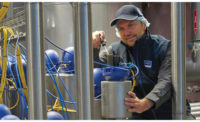The dairy industry has come a long way when it comes to the microbial quality of finished products. In general, the industry is doing a good job of staying out of the headlines. Nevertheless, food recalls and a recent listeriosis outbreak linked to soft cheese highlight that the industry can (and needs to) do better if the goal is to reduce product failures due to microbial contamination.
In all training related to HACCP, as well as the Preventive Controls for Human Foods rule, food processors are instructed to conduct hazard analyses by working through a process flow diagram and considering the risks of biological, chemical and physical hazards from the perspective of bulk product. The typical thought process asks how long the bulk product stays in one place with consideration of the environmental conditions (i.e., time and temperature) to evaluate the potential for microbial growth.
A new perspective
Given the level of automation and throughput of today’s dairy industry, bulk product is in nearly constant movement, and any given drop of milk or piece of cheese stays in one place for only short periods during production. Therefore, the logical conclusion is that there are no major concerns about microbial growth in dairy products during typical production cycles.
There is validity to this thought process, and it allows the industry to identify the most egregious of food safety risks, but it also relies more on logic than established facts. To truly understand and then control the microbial safety and quality risks of dairy products, evidence suggests that the production cycles and processing environments should be considered from new perspectives.
Over the past few years, our team of Oregon State University food microbiologists has worked with members of the dairy industry to investigate seemingly sporadic microbial contamination problems. Examples have included coliform detection in finished cheese and high lab pasteurized counts in pasteurized milk.
We have also investigated microbial growth in raw milk tankers, and we are currently evaluating microbial accumulation and growth in milk “sock” filters. Each of these investigations has yielded important information about microbial growth in the production environment, which can guide manufacturers in making prudent decisions for targeted changes that balance production goals with those of the quality and safety programs.
To shift to a more holistic — yet practical — assessment of microbial safety and quality risks, we suggest the following approach:
-
Extract the process flow diagram from your food safety plan.
-
Instead of marking the time at each step from the perspective of the bulk product, indicate the time between cleaning/sanitation events for each production area and each equipment piece and/or food contact surface.
-
Reconsider the potential for microbial growth within this context. Time between cleaning/sanitation represents the maximum potential for microbial growth in residual product and/or upon food contact surfaces during your production cycle. Microorganisms that grow between cleaning/sanitation cycles will come into contact with fresh bulk product that touches these surfaces.
-
Review your microbial testing and end-of-shelf-life results with this new perspective. If you are seeing an increase in the detection and/or counts of specific microbial populations in product later in the production day, then you likely have an area within your processing environment that is supporting significant microbial growth. You are far more likely to detect these problems in your quality program than in pathogen testing.
An example from the field
In 2018, we were approached by a cheese processor that had been dealing with a sporadic problem of detecting coliforms in its finished cheese. The processor would have periods with “clean” cheese samples and then have periods with intermittent coliform detection.
Standard practice was to visualize its quality results with production date on the x-axis and coliform count on the y-axis. This approach did not yield any patterns.
To combat the problem, the processor implemented a number of changes to its production and sanitation schedule. These changes included increasing the temperature of the pasteurizer and implementing an abbreviated cleaning step in a portion of its processing line during the middle of the production day. While the processor observed some improvement, these changes did not solve the problem.
After we were introduced to the problem, we toured the facility, asked many questions, reviewed historical data and collected samples of in-process product to verify or nullify assumptions. We looked at the historical data in new ways: We categorized samples as qualitatively present/absent and evaluated microbial load based on timing during the production day. We then collected in-process samples and used traditional cultural methods and molecular approaches to analyze microbial load at the beginning, middle and end of the day.
From the historical and newly generated data, we were able to identify one specific part of the production environment that supported significant coliform growth. In this case, coliforms were growing to fairly high cell counts — five log colony-forming units (CFU)/swab — on drain belt surfaces of the draining and matting conveyor during 18 hours of production. This increase correlated with the detection of coliforms in finished product at levels of 10-1,000 CFU per gram.
Once this hotspot of coliform growth was identified, the next question was, “Where were the coliforms coming from to cause this growth each day?”
Two sources seemed plausible: very low levels from raw milk that survived heat treatment or very low levels surviving cleaning and sanitation (e.g., cleaning in place) within the draining and matting conveyor. We were able to confirm the presence of low levels of coliforms in both the heat-treated milk and on sanitized belts of the draining and matting conveyor.
The takeaway message
In the example described above, reevaluating a food safety plan considering the timing since the last cleaning/sanitation event helped us identify a “hot spot” in the production environment that supported the growth of coliforms and other bacterial subpopulations. These hot spots have a high likelihood of impacting the microbial quality and safety of finished dairy products. Areas that can support rapid microbial growth — such as the drain belt of the draining and matting conveyor — should be identified, and management of these areas that can turn into “hot spots” should be a priority in revised food safety and quality programs.




